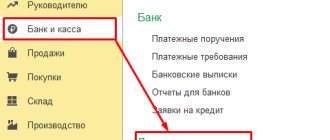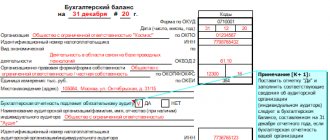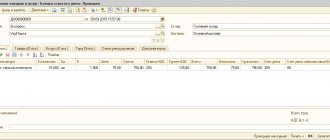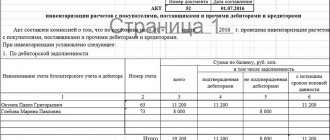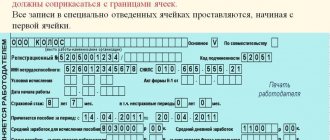Cash desk of economic entities
If an enterprise works with cash (receives sums of money from customers, issues them for reporting, receives them from a bank account, issues and accepts cash documents), then its responsibilities include conducting cash transactions. At the same time, cash discipline must be observed in terms of processing transactions, the procedure for issuing and receiving funds, and establishing an acceptable cash limit.
For more complete information, see the article “Cash discipline and responsibility for its violation.”
If the enterprise has the status of a small one or the business is registered as an individual entrepreneur, then cash discipline for such entities is less strict. For example, it is not necessary to approve a cash limit for them, as evidenced by the provisions of clause 2 of the Bank of Russia Directive No. 3210-U dated March 11, 2014.
For detailed information on the management of cash transactions by entrepreneurs, see the article “What are the features of cash discipline for individual entrepreneurs?”
How is it filled out?
As mentioned earlier, the accounts receivable entry in active account 50 contains detailed information about balances and cash flows for the specified billing periods. This summary is presented in a typical tabular form and contains the following important information:
- Analytical cash accounting items for which there was cash flow (receipt or outflow of funds) in a given reporting period. This may include, for example, payments to suppliers, payment of wages, repayment of financial obligations to banks and credit institutions, provision of internal loans to employees, repayment of internal loans by employees, cash receipts from customers, collection of funds to the servicing bank and other cash movements.
- Debit cash balance at the beginning of the analyzed reporting period.
- Cash inflow is the turnover of cash debit for the relevant items of analytical accounting.
- Cash outflow is the cash turnover for the relevant items of analytical cash accounting.
- Cash balance at the end of the analyzed reporting period.
- Results for opening/closing accounts of reporting periods and debit/credit turnover of analytical control accounts.
Receipt of money to the cash register: posting Dt 50 Kt 51 and others
According to the Chart of Accounts, approved by order of the Ministry of Finance of Russia dated October 31, 2000 No. 34n, account 50 “Cash” is active. In this case, cash receipts are reflected in the debit of account 50.
There may be several sources of replenishing the organization's cash register with funds. One of them is withdrawing money from a bank account. In such cases, the transaction is traditionally recorded by the following entry: Debit 50 Credit 51 .
But there are often situations where time gaps arise between the debiting of cash from one cash source of the company and its capitalization on another. For example, if the collector received funds from the bank at the end of the working day, it may not be possible to post the necessary amounts to the organization's cash desk to account 50 on the same day. In such cases, it is possible to use account 57 “Transfers in transit”:
- Dt 57 Kt 51 - receipt of funds based on a bank receipt to the responsible person (as of the date the cash collector received the cash);
- Dt 50 Kt 57 - posting of received cash to the cash desk (on the date of receipt of cash at the cash desk).
If the operation of withdrawing cash and crediting it to the cash register can be completed within 1 business day, then in accounting it will find a reflection that is already familiar to us: Dt 50 Kt 51.
The return of unused funds to the cash desk by accountable persons is accompanied by the following posting: Debit 50 Credit 71 - recording of unused amounts, balances of funds after the accountant purchases materials and pays for services.
You will find other information about the actions of accountable persons, including when returning funds, in the article “Features of advance reports in accounting.”
If cash comes from customers, then the replenishment of the organization’s cash desk is as follows: Dt 50 Kt 62.
Cash accounting: cash desk and bank
Purpose of the lecture:
study the features of cash accounting in 1C: Accounting 2.0.
6.1. General provisions
Cash transactions are an integral part of many business processes. Cash accounting is carried out on several accounts - in particular, this is account 50 “Cashier”
and account
51 “Current accounts”
. An example of a purely “technical” operation related to funds is the movement of non-cash funds from an organization’s current account to the cash desk and the reverse operation. Many other operations - the receipt of money into the organization and its outflow - are associated with the repayment of obligations by the organization to counterparties and the repayment by counterparties of obligations to the organization. Individuals and legal entities, employees of organizations, and tax authorities can act as counterparties. Now we will look at the features of accounting for funds in the cash register and in the current account.
6.2. Cash register
To account for cash transactions, the Chart of Accounts provides an active account 50 “Cash”
. Sub-accounts are opened for it, which are used in accounting records, detailing the specific types of cash desks used in the organization.
By default (Fig. 6.1), subaccounts 50.01 “Organizational cash desk”
,
50.02 “Operating cash desk”
,
50.03 “Cash documents”
.
Sub-accounts are also provided here for organizing the accounting of foreign currency - these are 50.21 “Cash of the organization (in foreign currency)”
and
50.23 “Cash documents (in foreign currency)”
.
Rice.
6.1. Chart of accounts: Account 50, subaccounts, subaccounts
As a subaccount, account 50 and most of its subaccounts use the subaccount Cash Flow Items
.
When creating cash documents, first of all, the system asks you to select a cash flow item. Subaccounts in which monetary documents are recorded (for example, vouchers, postage stamps, tickets) have a subaccount Cash documents
, and quantitative accounting is also kept for them. There is no point in keeping quantitative records of actual cash, but monetary documents, for example, vouchers to a holiday home, are characterized not only by their value, but also by quantity.
The main regulatory act, which regulates in sufficient detail the features of registration and accounting of cash transactions in an organization, is the “Procedure for conducting cash transactions in the Russian Federation”, approved by the decision of the Board of Directors of the Central Bank of the Russian Federation on September 22, 1993 No. 40 (outdated, new: 373-P of the Central Bank of the Russian Federation dated October 12, 2011).
Let's look at the features of cash receipts and the implementation of this process in 1C: Accounting.
Receipt of funds to the organization's cash desk
The receipt of funds at the organization's cash desk is documented by a cash receipt order. It is usually called PKO for short. The PKO form was approved in Resolution of the State Statistics Committee of August 18, 1998 No. 88 “On approval of unified forms of primary accounting documentation for recording cash transactions and recording inventory results.” There it is called: “Form No. KO-1”. The PKO (we will look at its appearance a little later) consists of two parts - an order and a receipt. When depositing funds into the organization's cash desk, a receipt is issued to the person who deposited them, and the order remains with the organization.
The order of movement of the PKO through the levels of the organization, in brief, is as follows. The accountant writes out the PKO, the organization's seal is put on the PKO, the chief accountant (or other authorized person) signs on it, after which the order is transferred to the cashier, who checks the details of the order, receives money from it and issues a receipt to the person who deposited the money.
Even before we get acquainted with the features of filling out a document that is used in 1C: Accounting, let's consider the issue of separating the functions of an accountant and a cashier during the automated processing of cash orders.
The accountant can generate a cash receipt order, print it on a printer (in order to put the necessary signatures and seals on the paper copy of the order) and hand it over to the cashier. In this case, the accountant, after generating an electronic document, writes it down in the system, but does not post it - that is, clicks on the Write button in the document form and does not touch the OK button. After the document is recorded, it will be saved in the database, but will not generate any movements in the registers. That is, there will be a document, but it will not have any impact on the state of accounting, on the state of accounting registers. When the cashier finishes working with the PPO, he receives the required amount for it - he can find the document in the database, open it and post it by clicking on the Post button in the document form.
Well, if the money under the PKO is never deposited, the document will remain recorded, but not posted, that is, it will not affect the state of accounting.
The cashier, in addition to the above-described manipulations with the PKO, must register the order in the cash book (F No. KO-4). 1C:Accounting also takes care of the formation of the cash book. Despite the fact that accounting is almost completely automated, some information - such as the same PKO or cash book sheets - is not yet completely entrusted to electronics. Therefore, a lot of things - in particular, the sheets of the cash book, which we will talk about below, have to be printed, filed, stored - as in ordinary accounting.
The procedure for processing documents in each specific accounting department may differ from the standard one. This applies not only to cash transactions.
Registration of PKO
In order to open the list of documents for PKO, you can either use the link Cash receipt order
on the
Cash of the Function Panel
, or execute the command
Cash Desk > Receipt Cash Order
.
In the list window that appears, click on the Add
- a window for selecting the type of document will appear (Fig. 6.2).
Rice.
6.2. Selecting the type of transaction for a cash receipt order
Below (Table 6.1.) the types of documents (transactions) that can be used to organize the receipt of funds are listed, as well as examples of transactions with accounting records containing correspondence of accounts.
Please note that here and below we will mainly show schematic entries, which will be converted to a more detailed form during accounting. In particular, in 1C: Accounting, account 50 is not used in postings - it is represented in postings by its own subaccounts. Table 6.1. Types of PKO document and reflection of various business transactions
| № | Document type | Business transactions | D | TO |
| 1 | Payment from the buyer | Revenue received from the sale of goods, works, services | 50 | 62 |
| 2 | Reception of retail revenue | Cash received from the operating cash desk to the organization's cash desk | 50.01 | 50.02 |
| 3 | Return of funds by the accountant | The balance of the accountable amount was deposited in cash at the organization's cash desk | 50 | 71 |
| 4 | Refund by supplier | Previously paid funds were received from the supplier for undelivered products | 50 | 60 |
| 5 | Receiving cash from a bank | Received funds from the bank using check No.___ for the purposes of _____ | 50 | 51 |
| 6 | Settlements on loans and borrowings with counterparties | Received funds to repay a commercial loan | 50 | 76 |
| 7 | Other cash inflow | Revenue from the sale of fixed assets, materials, intangible assets, etc. was capitalized. | 50 | 91, 76 |
| During the inventory, cash surpluses were identified, the identified surpluses were credited to the cash register | 50 | 91 | ||
| Funds were received from employees of the organization to compensate for damages from financially responsible persons, payments for services, etc. | 50 | 73 | ||
| Contribution was made to the authorized capital in cash | 50 | 75 |
Sales of goods: we issue an invoice and accept funds in advance
Let's look at an example. LLC "Mebelshchik" sells LLC "Rassvet" the product "Woodwork" in the amount of 10 cubic meters. meters for 4720 rubles. for 1 cubic m., incl. VAT. Sales are carried out on an advance payment basis, the advance payment is made to the organization's cash desk.
To correctly reflect such a transaction in the accounting accounts, it is necessary to take into account not only the fact of receipt of an advance payment from the buyer and shipment of goods, but also VAT accounting.
It is clear that such an operation will affect profits and, as a result, will affect the calculation of income tax. The general scheme of accounting records in this case looks like this, table. 6.2. Table 6.2. Sales of goods on prepayment
| № | Accounting transaction | D | TO | Note, reasons for recording |
| 1 | Receiving an advance from the buyer to the cashier | 50 | 62.02 | Receipt cash order |
| 2 | VAT accrual on advance payment | 76.AB | 68.02 | Accounting statement, invoice |
| 3 | Transfer of goods to the buyer (sale prices) | 62.01 | 90.01 | Consignment note (form No.TORG-12), invoice |
| 4 | Settlement of buyer's prepayment | 62.02 | 62.01 | Accounting information |
| 5 | Acceptance for deduction of VAT previously accrued on the advance payment | 68.02 | 76.AB | Accounting information |
| 6 | VAT accrual on sales | 90.03 | 68.02 | Sales invoice, |
| 7 | Write-off of the cost of goods | 90.02 | 41.01 | Accounting information |
Now we are implementing the first operation from the above sequence, namely, we will accept funds from the buyer at the cash desk. But we will not begin entering data for this operation by creating a new PKO
, and from the creation of the document
Invoice for payment to the buyer
.
This is a fairly simple document in nature that allows you to issue an invoice to the buyer. The issued invoice does not mean anything yet, it does not generate transactions - it only allows you to generate a printed document - Invoice for payment
, transfer it to the buyer, and when the buyer is ready to pay the invoice, enter an incoming document for accounting of funds based on the issued invoice - or cash (as we we will do in this case), or - banking.
The mechanism for entering some documents based on others is very convenient; it is used not only when working with cash or bank documents, but also in many other cases. The essence of this mechanism is that the system, upon receiving an input command on the basis, automatically fills in most (or all, it all depends on the characteristics of the relationship of specific documents) details of the new document, analyzing the details of the base document. This increases the speed of work and reduces the likelihood of errors.
Let's create a new document Invoice for payment to the buyer
.
To do this, you can use the Account
on
the Sales function panel
or execute the menu command
Sales > Account
.
In the list window that appears, Invoice for payment to the buyer
, add a new document and fill it out as shown in Fig. 6.3.
Rice. 6.3. Invoice for payment to the buyer
Postings from cash documents
An organization's cash register is a record of not only cash, but also other financial documents.
The following subaccounts can be opened for account 50:
- 50.1 - the main cash register used;
- 50.2 - operational cash desk, if the institution has several facilities for accepting money;
- 50.3 - purchased financial documents for a specific purpose (vouchers, tickets, coupons, etc.).
To reflect the receipt of monetary documents in correspondence with account 50, account 76 “Settlements with various debtors and creditors” can be used: Debit 50 Credit 76.
After this, the received documents can be issued, for example, for reporting to employees sent on a business trip: Debit 71 Credit 50.
Working with CCP (cash register equipment)
Many entities are required to use cash register systems in their activities due to legal requirements. These include enterprises that accept cash as payment from the public or contractors. Cash transactions in such cases are also subject to mandatory documentation.
All funds received via cash register are transferred to the organization’s main cash desk, as a rule, at the end of the shift (working day). Revenue can be transferred using PKO, or directly credited to the cash register.
If the institution provides a separate position for a cashier-operator, then the delivery of cash is accompanied by filling out a certificate-report in form No. KM-6, which contains information about the readings of cash register counters and the amount of cash received. In small organizations, this form is replaced by filling out a log for each cash register machine that records meter readings and cash flows.
Some categories of taxpayers are allowed not to use cash register systems when making cash payments. In such cases, they should be ready to issue strict reporting forms upon payment or provide, upon request, issued sales receipts confirming the fact of purchase. Subjects that may not use CCP include:
- Organizations and individual entrepreneurs on UTII or on the patent taxation system.
- Entities engaged in certain activities, the list of which is approved by law. This includes trading in kiosks, small retail peddling, sale of lottery tickets, securities, sale of religious products and other work.
- Institutions located in hard-to-reach and remote areas.
- Pharmacy organizations in rural areas.
Despite the fact that the use of cash registers for the listed entities is not a prerequisite, they still need to comply with other cash discipline.
Receipts from other sources: posting Debit 50 Credit 91
To register other receipts not related to normal operating activities at the organization’s cash desk, in some cases account 91 corresponds with the debit of account 50 for the loan:
- when identifying excess funds in the cash register;
- to reflect exchange rate differences.
Reflection of exchange rate differences using posting Dt 50 Kt 91 occurs in the event of a positive exchange rate difference. If the exchange rate difference is negative, the posting looks like this: Dt 91 Kt 50.
Inventory of the cash register in the organization
Considering that the cashier or other person responsible for maintaining the cash register is financially responsible, they periodically conduct an inventory of the cash register. Actions are relevant when changing officials, reorganizing an entity, preparing financial statements, as a result of natural disasters or establishing facts of theft. Read the detailed article ⇒ “How the cash register inventory is carried out”
For these purposes, an inventory commission is created. During the process, the presence of a financially responsible person is required. Acts confirming actions (inventory lists) can be developed independently. At the same time, balances on monetary documents are also reconciled.
If a surplus or shortage is identified, you must obtain a written explanation from the cashier. All missing amounts are repaid at the expense of the responsible persons if there is a previously concluded agreement on liability with them. If the perpetrators are not identified (theft), all losses are written off at the expense of the enterprise.
Postings for cash withdrawal from the cash register
To meet the current needs of the organization, it is possible to use the cash available in the cash register. The list of expenses that can be made using amounts received as payment for goods and services of the company is reflected in clause 2 of the Bank of Russia Directive No. 3073-U dated October 7, 2013. These include, in particular:
- Salary, social benefits: Dt 70, 69 Kt 50.
- Payment for goods, works, services. At the same time, cash payments between legal entities and individual entrepreneurs are allowed if the amount of cash payments under the agreement does not exceed 100,000 rubles. (clause 6 of instruction No. 3073-U): Dt 60 Kt 50.
- Issuance of accountable amounts to employees to make current payments to the organization and pay for necessary services and materials: Dt 71 Kt 50.
- Refund of funds for failed transactions, if preliminary payment was made earlier in cash: Dt 62 Kt 50.
Payment of accrued dividends to the founders directly from the proceeds received at the cash desk is unacceptable. The exception is amounts received at the cash desk in other ways: withdrawal of cash from a current account for these purposes, return of imputed amounts. If the organization is a joint-stock company, then payment of dividends is possible only by transferring non-cash funds in accordance with clause 8 of Art. 42 Federal Law “On Joint Stock Companies” dated December 26, 1995 No. 208-FZ
It is also prohibited to use the proceeds received at the cash register for the subsequent issuance of loans or payment of rental payments for real and movable property.
Cash discipline - who is obliged to follow the rules?
Not all institutions and individual entrepreneurs can do without using cash in the course of their work. From time to time there is a need for settlements with staff, suppliers and customers. Goods and materials necessary to maintain the life of the enterprise are purchased for cash. This could be stationery, purchasing materials from markets.
| ★ Best-selling book “Accounting from scratch” for dummies (understand how to do accounting in 72 hours) > 8000 books purchased |
When working with cash, enterprises and individual entrepreneurs are required to comply with the requirements of cash discipline. A liability agreement is concluded with the person responsible for making cash payments.
Cash discipline includes compliance with the procedure for working with money in account 50. It is mandatory to record the movement of funds (receipts and expenses) using standardized document forms. The main ones are PKO and RKO. When filling them out, blots and corrections are not allowed.
The result of cash flow is recorded in the cash book daily (subject to the existence of transactions). All transactions for the receipt and issuance of funds are reflected, indicating the numbers of supporting documents (RKO and PKO) and the content of the operation.
Cash discipline also establishes restrictions on the use and storage of cash amounts - the cash limit. Calculations are made by the entities themselves based on the daily cash needs and the amount received.
If there are separate divisions that use cash payments, the cash limit is set taking into account the revenue of these divisions.
The cash register limit also regulates the period of storage of money in the cash registers. To avoid exceeding the established indicator, excess cash should be periodically deposited into the current accounts of credit institutions. Exceeding the storage period is allowed on the days of settlements with employees for salaries and on weekends.
Restrictions on balances may not be observed by small businesses and individual entrepreneurs. They are allowed to keep cash in cash registers without restrictions. It is recommended to issue an appropriate local act confirming such a right.
Example . The Romashka organization has set a cash limit of 50,000 rubles. At the beginning of the working day, the cash balance was 17,841 rubles. During the day, the following transactions occurred: payment was received from customers in cash in the amount of 33,815 rubles and 16,592 rubles, funds were issued to the accountable person for the purchase of stationery - 8,500 rubles.
The total receipts to the cash desk amounted to 50,407 rubles:
Dt 50 - Kt 62 - 33815 rubles;
Dt 50 - Kt 62 - 16,592 rubles.
Expense transactions are equal to 8500 rubles:
Dt 71 ― Kt 50 2015 funds were issued for reporting
The cash balance at the cash desk at the end of the day is 17,841+50,407-8,500=59,748 rubles.
Excess amounts in the amount of 9,748 rubles must be handed over to the bank.
Failure to comply with cash discipline entails fines of up to 50,000 rubles for organizations and up to 5,000 rubles for officials.
conclusions
The balance sheet register compiled for account 50 is considered a convenient and simple report that clearly reflects information about the balances (balances) and turnover (movements) of the cash register.
However, one cannot fail to note its enormous usefulness and information content for the cash accounting of any business entity.
The balance sheet generated for the cash register account allows you to detail the movement of cash by sources of receipt and areas of expenditure.

